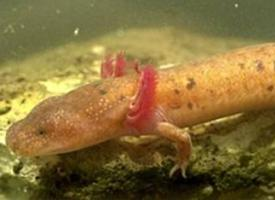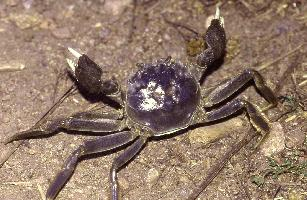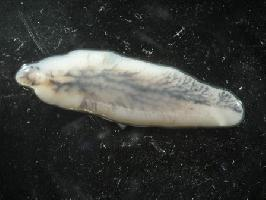
Stav ohrožení
| Ohrožen |
Popis zvířete
The Tennessee cave salamander (Gyrinophilus palleucus) is a fascinating and unique amphibian species endemic to the United States, primarily found within the limestone caves and underground streams of the Southern Appalachian region, including Tennessee, Alabama, and Georgia. This species is part of the Plethodontidae family, also known as lungless salamanders, a group characterized by their lack of lungs and their reliance on cutaneous (skin) and buccopharyngeal (mouth and throat) respiration for gas exchange.Physical Description:
The Tennessee cave salamander is a large, robust creature, with adults typically reaching lengths of up to 20 centimeters (about 8 inches), making it one of the larger species within its family. Its body is elongated with a broad, flattened head, which aids in navigating the aquatic environments of its cave habitats. The skin of this salamander is smooth and slippery, with a coloration that ranges from pinkish to a pale orange or yellow, often with darker spots or blotches that provide some camouflage against the cave floors and walls. The limbs are relatively short but well-developed, and the tail is long and laterally compressed, acting as an efficient rudder during swimming.
One of the most striking features of the Tennessee cave salamander is its external gills, which are prominent, bushy, and red, protruding from either side of the head. These gills are a key adaptation to its aquatic lifestyle, allowing for efficient oxygen absorption directly from the water.
Habitat and Distribution:
This species is strictly aquatic and is found in the cool, clear, and oxygen-rich waters of subterranean cave systems. It prefers habitats with a stable environment, avoiding areas subject to frequent flooding or pollution. The specific conditions of caves, including constant temperature and high humidity, are crucial for the survival of the Tennessee cave salamander.
Behavior and Diet:
The Tennessee cave salamander is a nocturnal predator, relying on its keen sense of smell and touch to navigate the dark environments of its habitat in search of prey. Its diet consists mainly of small invertebrates found within the cave systems, such as insects, spiders, and crustaceans. The salamander employs a sit-and-wait strategy, remaining motionless until prey comes within striking distance, at which point it quickly lunges forward to capture its meal.
Reproduction:
Little is known about the reproductive habits of the Tennessee cave salamander due to the difficulty of observing these elusive creatures in their natural, dark habitats. However, it is believed that reproduction occurs in water, where females lay eggs that are then fertilized externally by the male. The eggs are laid in hidden crevices or under rocks to protect them from predators. The larvae are fully aquatic and resemble the adults, though smaller and with more pronounced gills, undergoing a gradual metamorphosis as they mature.
Conservation Status:
The Tennessee cave salamander is listed as a species of concern in some of its range due to habitat destruction, pollution, and disturbance from human activities. The fragility of cave ecosystems makes them particularly susceptible to changes in water quality and temperature, which can have devastating effects on the species that inhabit them. Conservation efforts are focused on protecting the caves and surrounding environments to ensure the survival of this unique and specialized salamander.
In summary, the Tennessee cave salamander is a remarkable example of adaptation to life in the perpetual darkness of underground water systems. Its existence highlights the importance of cave ecosystems and the need for continued conservation efforts to protect these unique habitats and their inhabitants.
Podobná zvířata
Nové fotografie zvířat
Top 10 zvířat
- Chinese water dragon (Physignathus cocincinus)
- Galápagos tortoise (Geochelone nigra complex)
- Dolphin gull (Leucophaeus scoresbii)
- Japanese macaque (Macaca fuscata)
- Colombian red howler (Alouatta seniculus)
- Sea urchins (Echinoidea)
- Moustached guenon (Cercopithecus cephus)
- Diana monkey (Cercopithecus diana)
- Common reed warbler (Acrocephalus scirpaceus)
- Common house mosquito (Culex pipiens)


